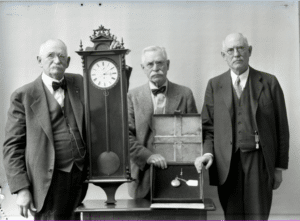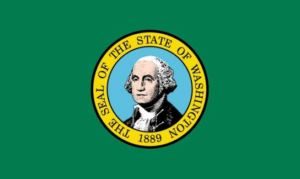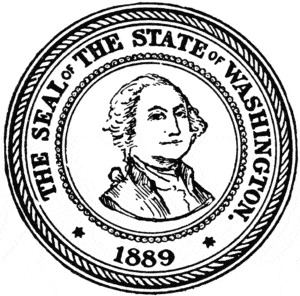
Notes From Olympia: April 7, Week 13 of the 2023 Legislative Session
This edition focuses on what we can expect as the end of session approaches, details on the final process of a bill becoming law and creation of the Washington state flag.


Gorgeous cherry blossoms brighten the Capitol campus
(Photo Credit: Erica Hallock)
Trivia!
Washington state was admitted to the Union in 1889. How many years did it take for the state to adopt an official state flag?
The Homestretch: What to Expect at the End of the Legislative Session
Monday was budget day in the House of Representatives with debate, consideration of amendments and ultimate passage of the Operating and Transportation budgets. As a reminder, the Washington Fiscal Information website contains links to the budget bills and their details. And Start Early Washington’s resource page includes a comparison of the various early learning budget-related proposals released to date.
As we near the final weeks of the legislative session, the Legislature faces deadline after deadline in rapid succession. After the April 4 fiscal committee cutoff earlier this week, attention quickly pivoted back to Floor activity as lawmakers worked to debate and pass bills that originated in the opposite chamber in advance of the April 12 deadline. At the same time, budget writers continue negotiations to reconcile differences between the two bodies’ approaches prior to the scheduled April 23 adjournment. Legislators, staff and lobbyists are all fatigued, but an end is in sight and the beautiful cherry blossoms throughout the campus are inspiring.
Legislative Lowdown
I have seen a lot of questions recently about the process for a bill to become a law during these frenetic final days. As we all know, this process is far more complex than Schoolhouse Rock led us to believe. The legislative website contains a full description of this process.
Here’s a quick synopsis:
Bills not amended in the opposite chamber. Bills that pass out of the opposite chamber without any amendments move directly to the Governor. For example, if the Senate approves a bill exactly as it left the House, the bill moves straight to the Governor’s desk.
Bills amended in the opposite chamber. Bills amended in the second body must return to its original chamber so that entity can decide if it will “concur” with the other body’s changes. Bills amended in the opposite chamber are placed on the Concurrence Calendar in the House and the Concurring Calendar in the Senate (it would be interesting to learn why the slight difference in the naming of these calendars).
What happens if the first body disagrees (or fails to concur) with amendments made in the opposite body? When the original body does not concur with the amendments made in the opposite chamber, the originating body can request that the opposite chamber “recede” from its amendments. If the second body agrees to recede, the bill proceeds to the Governor.
If the second body does not agree to recede from its amendments, one of the bodies can ask for a “conference committee” representing members from both the Senate and House to work to resolve differences. (In legislative lingo, you may hear the statement that a “bill has gone to conference.”). If the conference committee is able to agree, it will produce a conference report that would then go before both chambers. Importantly, conference committee reports cannot be amended after adoption. If both bodies approve the conference committee report, the bill moves to the Governor. If one of the bodies does not approve the conference committee report (or does not take a vote), the bill fails.
After the votes are taken, do bills go to the Governor? Not quite. After bills pass third reading in both chambers, they must first be signed by the Speaker of the House, the Chief Clerk of the House, the President of the Senate and the Secretary of the Senate prior to transmittal to the Governor. This process is called enrollment. Prior to recent advancements in technology, the signed, paper bills were physically submitted to the Governor’s office. It is, of course, now done electronically, but there can still be a lag before it reaches the Governor.
Does the Governor have a time limit for acting on bills? Engrossed bills must be acted on by the Governor within five days of receipt unless the bill passes the Legislature with fewer than five days before adjournment. In that case, the Governor has 20 days to act on the bill (excluding Sundays). For the 2023 legislative session, the five-day cutoff is April 17. This means that bills that reach Governor Inslee’s desk by April 17 must be acted upon within five days.
The Governor may sign, veto or line-item veto parts of bills and usually executes at least a few vetoes every year for various reasons. It is possible for the legislature to override a Governor’s veto, but it does not happen often, particularly when the Governor and the legislative chambers are led by the same party.
The Governor’s website includes schedules of expected bill actions. Note that bill signings are no longer open to the general public but can be view on TVW.org.
Bill Tracker: Key Early Learning Bills
As the legislative session progresses, our resource page will be updated with a weekly bill tracker. Please note that legislation changes quickly, so the version on our website may not represent a bill’s latest version as it is published the Thursday of each week.
Trivia Answer
It took the state 34 years to adopt an official state flag.
Washington state was admitted to the Union in 1889 but did not adopt an official design for the Washington state flag until 1923 after a yearslong effort led by the Daughters of the American Revolution (DAR).
During the 1800s, as a number of states were admitted to the Union, state flags were not seen as critical, and many veteran groups believed that only the American flag should be flown. As a result, many state flags were a common, basic design with a blue background and the state seal in the middle. Several states continue to use that basic design today. The Washington state seal itself was co-designed and created by brothers Charles, Grant and George Talcott, who owned and operated several businesses in Olympia, including Talcott Jewelers, the location of the original printing of the first state seal.
 The Talcott Brothers – Charles, Grant, and George circa 1960
The Talcott Brothers – Charles, Grant, and George circa 1960
(Photo Credit: Olympia Historical Society)
Many Washingtonians wanted a more unique flag for the state and, after years of prototypes and lobbying, the Legislature approved the flag design we have today on March 5, 1923. That flag became official on June 7, 1923 – almost 100 years ago. The Washington state flag is the only U.S. state flag with a green background, representing the Evergreen State moniker, as well as the only state flag with the image of a president. The flag has seen minor updates including the modernization of the flag’s colors in 1955 and a slight update to the seal in 1967.
Many flag aficionados and the North American Vexillological Association have criticized the Washington flag for its lack of originality, inclusion of words and use of an image of an individual who never stepped foot in the state. There have been calls to create a new flag to better represent Washington, much like Utah did this year after a public design competition. What would you include if you could create a new flag for Washington?
 Current Washington State Flag
Current Washington State Flag
 Original State Seal, 1889
Original State Seal, 1889
(Photo Credit: University of South Florida)
Bonus Trivia: Construction Update
Work continues on the demolition of the Newhouse Building as workers remove the upper portion of the building piece-by-piece (the white concrete blocks in the forefront of the picture represent the portions removed so far). I will be curious to see how far they get in the next 16 days.

(Photo Credit: Erica Hallock)
About the Author

Erica Hallock
Director, Policy & Advocacy, Start Early Washington
Erica Hallock serves as the Director of Policy and Advocacy for Start Early Washington. She has worked in early childhood, health and human services policy in both California and Washington state.
More Like This
Contact Us
Connect with our team to learn more about our work or discuss how we can support policy and advocacy work for your organization.
Washington State Hub
Learn more about our work in Washington state and access relevant resources and publications.
